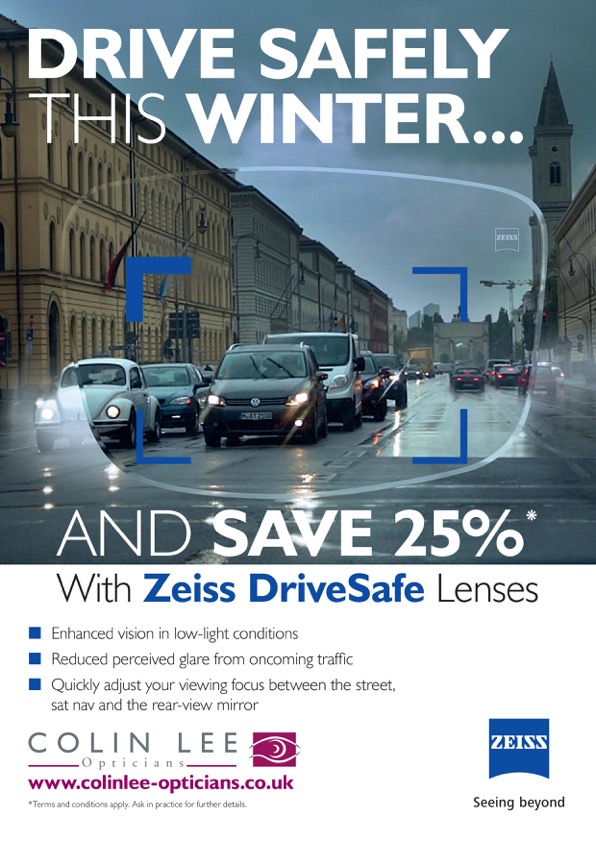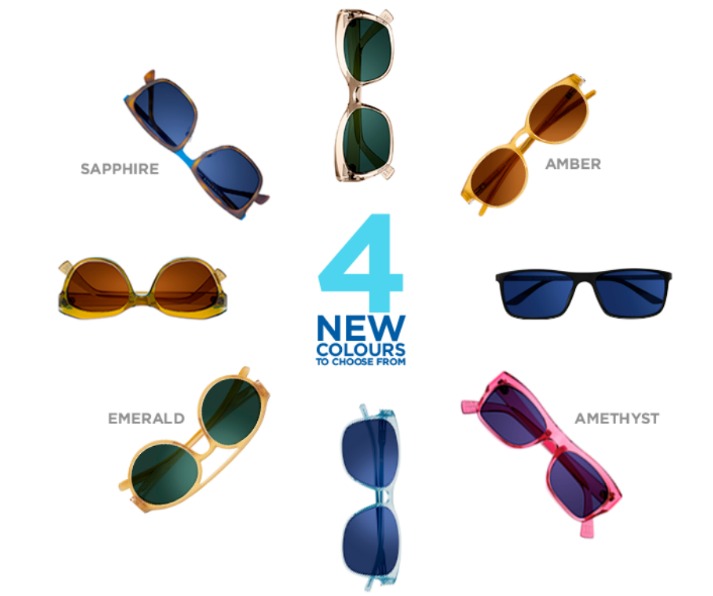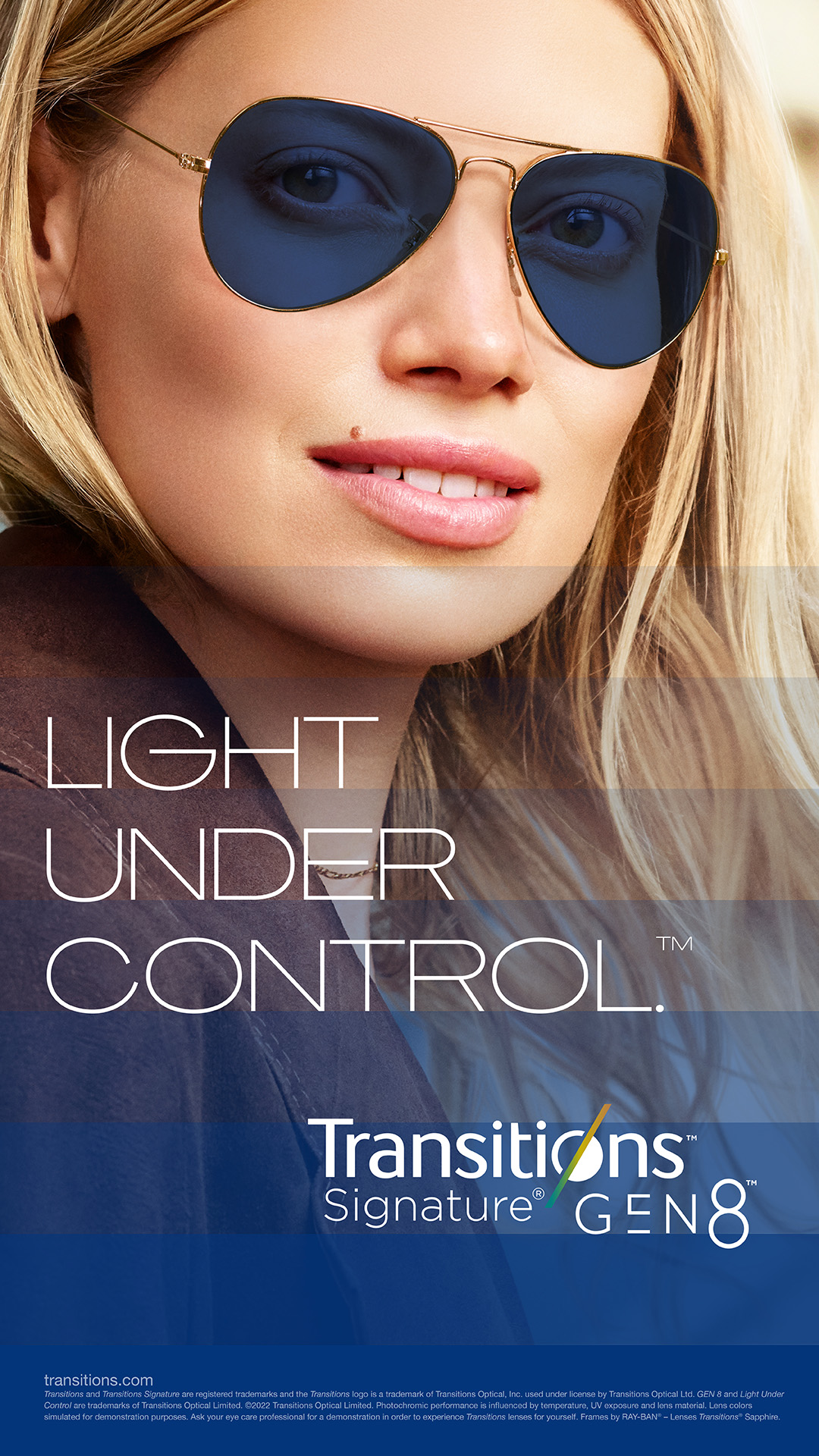Blog, News & Offers
Winter driving conditions, Drivesafe promotion and what can you do to help?
Posted on Monday, October 24, 2022

Winter is well and truly coming and with it are some of the most challenging driving conditions where sight is concerned.
If you’re not driving in the dark, you will be faced with very low sun and lots of road surface reflections which are worse still in the rain.
What that means for your eyes is either dark driving conditions with headlights, or low sun and glare from the road.
From now until the end of December we will be offering Zeiss drivesafe lenses at 25% off.
These are a specialist lens designed specifically to enhance vision in all driving conditions aiming to provide:
1. better vision in bad weather, at night or at dawn or dusk
2. less glare
3. fewer vision problems when shifting focus
So how do they create a lens that's not only ideal for driving but also for everyday life?
A// ZEISS Luminance Design™ technology
ZEISS DriveSafe features an optimised lens design that takes into account the size of our pupils in poor light. There is one lens design for single vision lenses and one for progressives. The result: improved and unimpaired vision when driving in poor light.
B// ZEISS DuraVision DriveSafe lens coating
With DriveSafe, ZEISS has used a special new coating to take into account the many different situations during driving when our eyes are confronted with glare. The DuraVision® DriveSafe coating by ZEISS partially reflects wavelengths in the high-energy, visible portion of the blue light spectrum, including the band around the wavelength of 450 nm. DuraVision® DriveSafe Coating by ZEISS therefore reduces discomfort glare by up to 64%* compared to premium Anti Reflective coatings.
C// ZEISS DriveSafe lens design for progressives/varifocals
ZEISS offers a special design to make driving with progressive lenses more comfortable and safer. The optimised vision zones make it easier for the eyes to refocus when moving between the road ahead and the dashboard and the rear view or side mirrors. Horizontal movements of the head are reduced. At the same time, the near zone is designed so that DriveSafe glasses can be worn all day long – they are also suitable for other activities, including reading
But these lenses are not the only thing you can do to make your life easier feeling more confident and safe on the road this winter.
Here are our practical and optical tips:
1) Make sure your sight is corrected, best as can be.
A study in 2018 found that over 3000 road collisions in the UK involved a driver with vision below the driving limit. Some with vision that couldn’t be improved by wearing spectacles but there are so many drivers who vision could and should be improved to a good and safe level for driving.
There are thousands of drivers out there this very moment in the UK who are within the driving limits but who could see much sharper. Why settle for ok when you could have HD correction.
Even more worryingly there are many out there who fall below the driving level, who can be corrected by specs who choose not to be putting theirs and other road users safety in jeopardy. Police in the Midlands and Staffordshire have been given increased powers to stop and test people’s sight at the roadside, revoking licences on the spot if you fail to see the licence plate from 20m away.
Some individuals are aware that their vision is not good enough for driving and choose to drive anyway, but many are completely unaware that they no longer meet the vision driving requirements, often because their vision has deteriorated slowly with time, which can be more difficult to detect. This teamed with a low awareness of the visual standard to read a number plate at 20 meters away on a clear day, leads to individuals driving illegally. Another study found that 50% of Optometrists had come across one or more individuals that knew they not meet the driving standard, but said they would continue to drive anyway, during a one month period.
One of these people may be a friend or relative of yours. Many have glasses but won’t wear them others may not have had a test in years. It’s important to educate these people in the importance of correcting their sight when driving, it could save a life.
If you haven't had a sight test in the last 2 years, get yourself checked out.
2) Keep you windows and mirrors clean
By keeping your windows and windscreen clean, you can avoid extra glare and condensation. This is especially prevalent in Winter, with the falling leaves and debris. Dirty mirrors can reflect and distort light so keeping them clean is essential to a safe drive. If it has been raining, then make sure you give them a wipe, so the droplets don’t further disrupt your vision. Don't forget to clean the inside of the windows too, often dirt can be on the inside windows which demist pads just smear making things worse.
3) Polarised sunglasses
Sunglasses are a key item all people should have. But if you are a driver, make sure they are polarised. Ordinary sunglasses only protect and relieve your eyes from the brightness of the sun, polarised lenses also eliminate glare that reflects off the road surface and dashboard. Polarised lenses are available in all lens forms from all our practices.
4) Coatings and coloured filters.
Lens manufacturers spend a lot of money in research and development of new coatings and tints which may improve a patient’s lifestyle. Driving coatings and tints are a big part of this development especially as headlight brightness and colour has changed with the introduction of a bluer based LED bulb.
In a nutshell a yellow filter helps with the brightness and colour of this LED bulb.
You may have seen some adverts selling yellow driving lenses or clip on’s. Sadly the vast majority of these are illegal for night driving in the UK as they leave you unable to see certain colours and therefore miss hazards on the roads.
Lens manufacturers have managed to create a coating which gives this yellowing and therefore dampening effect to the brightness of headlights while still giving you clarity of other colours, making them safe for night driving.
These coatings can be applied to single vision and Varifocal lenses.
However for some the yellowing can be a hindrance when not driving so they are more suitable as a second pair for specialist use when driving.
5) Transitions XTRActive
Normal photochromic lenses react when UV light hits the surface of the lens causing a change in the molecules meaning the lens goes from clear to tinted. The problem in a car is that most of the UV is reflected off the windscreen meaning they react poorly inside a car.
Transitions XTRActive work differently meaning they react and adapt to the levels of light you experience whilst driving and even leave a mild tint to help with unwanted headlight glare when clear whilst conditions are dark outside. This type of treatment can now be applied to the majority of lens types.
6) Driving Varifocals
There are now specialist varifocals for use when driving. Rather than the conventional design of a varifocal where the narrowest field of view is the intermediate range (the distance at which the speed dials etc sits), a driving varifocal gives an extra wide distance field of view and a much wider intermediate range, sacrificing the near distance area which is not needed when driving.
These again are best served as a second pair as not having the near area can be a hindrance to everyday life.
7) Don’t look directly into the lights
Headlights when directly looked at leave an after image for several seconds on the retina making it difficult to re adjust to the dark road. Avert your gaze keeping your eyes focused down on the road rather than up into the lights.
If you have any questions about lenses which may help you in these conditions call your nearest practice today, where one of our Dispensing Opticians will be happy to discuss our range and offers.
Upgrade to transitions, react to light lenses for £25
Posted on Saturday, October 15, 2022


Until the end of November you can now upgrade any pair of lenses for only £25 to enjoy the latest Gen 8 transitions technology.
Not only that, you can now protect your eyes in even more style than ever before with the transitions technology available in a variety of colours, mirrors and with polarising filters in the brand new xtractive polarised option.
Gen 8 is the latest technology available and not offered in all optical practices. Faster to go both dark and clear than ever before, darker in outdoors and now fully clear indoors are the main improvements made in this latest edition.
Along with the traditional colours of Grey, Brown and Graphite green we are now able to offer "style colours" of Amber, Amethyst, Emerald and Sapphire to truly compliment your frame style to lens colour as well as provide a more colourful outlook.
Recent advancements in technology have also now allowed polarising filters and mirrors to be added to this technology meaning they are clear indoors and then react outdoors to either offer fully mirrored or fully polarised protection, style and comfort.
All of these options are available in your local practice as a £25 upgrade on the clear lens price. Options available in single vision, bifocal and varifocal subject to availability.
Have a look at the options to best suit your style and visual needs by clicking the following link https://www.transitions.com/en-gb/products/?gclid=CjwKCAjwtKmaBhBMEiwAyINuwLLIe-eTGX_OiPUDfcohqFpIEYZGsg9XIpNs1179Ras-6OIZGhXA-hoC5uIQAvD_BwE#style-colors
Blog Search
Blog Categories
- News (62)
- Sunglasses (3)
Blog Archives
- March2024 (1)
- November2023 (1)
- October2023 (1)
- August2023 (2)
- June2023 (2)
- April2023 (1)
- November2022 (1)
- October2022 (2)
- September2022 (1)
- August2022 (4)
- June2022 (3)
- May2022 (3)
- March2022 (3)
- December2021 (1)
- November2021 (2)
- July2021 (2)
- June2021 (1)
- May2021 (2)
- April2021 (3)
- March2021 (2)
- February2021 (4)
- January2021 (1)
- December2020 (1)
- November2020 (2)
- October2020 (1)
- September2020 (2)
- July2020 (1)
- April2020 (2)
- March2020 (3)
- January2020 (1)
- July2019 (3)
- June2019 (2)
- February2019 (1)
- October2016 (1)
- September2016 (1)
- June2016 (1)
Offices
- Aldridge (1)
- All Offices (24)
- None (37)